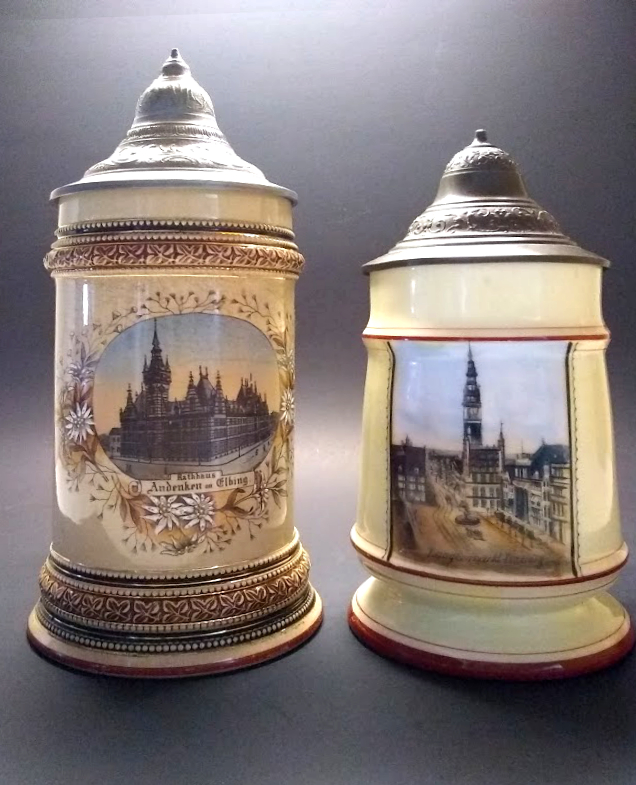
 Stein Collectors International
Stein Collectors International
Featured Stein: September 2019

 Stein Collectors International
Stein Collectors International
Featured Stein:
September 2019
| ~ Two Souvenir Steins from the Province of
West Prussia
~ By Ken Stroud |

I have a Mennonite family heritage from Prussia, and have sought steins from that region for many years. The cities of Elbing and Danzig were the two largest areas of substantial Mennonite settlement during the 1600-1700’s. I have had a tourist type stein from Elbing for some time, and was thrilled when I was able to purchase a stein from the city of Danzig. The pottery stein from Elbing is at left in the photo, while the porcelain stein at right is from Danzig.
West Prussia was established as a province of the Kingdom of Prussia in 1773. It was dissolved in 1829 and merged with East Prussia to form the Province of Prussia, then re-established in 1878 when the merger was reversed and it became part of the German Empire. From 1918, West Prussia was a province of the Free State of Prussia within Weimar Germany, but as result of the Treaty of Versailles, subsequently lost most of its territory to the Second Polish Republic and the Free City of Danzig. It's admittedly contorted and somewhat confusing.
West Prussia was notable for its ethnic and religious diversity due to immigration and cultural changes, with the population becoming mixed over the centuries. Since the early Middle Ages the region was inhabited by numerous Slavic and Baltic peoples, such as Pomeranians in the Pomerelia region, Old Prussians and Masovians in Kulmerland, and Pomesanians east of the Vistula River. Later Germans followed. Germans were also the largest group in West Prussia until its dissolution in 1922, with large numbers of Kashubians, Poles, Mennonites, and Jews also settling in the region.
Suffice it to say, when these steins from the cities of Elbing and Danzig were produced, both cities were a part of Germany. Danzig, known today as Gdansk, and Elbing, now known as Elbląg, are today part of Poland.
The stein on the right in the photo is porcelain and shows the Danzig Langenmarkt with the distinctive Rathaus tower (which is still there), and if you look closely you can see Neptune’s fountain. The stein features a lithophane in the base which shows men drinking around a table.
The second stein is pottery with a picture of the imposing Elbing Rathaus (which unfortunately was destroyed in WW II). Of note, this is a very generic stein body and there are Edelweiss flowers around the picture which of course are found nowhere near the Baltic!